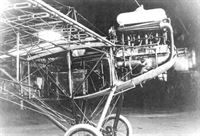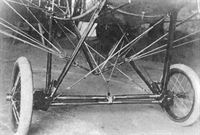
Описание
Страна: Германия
Год: 1913
J.Herris Roland Aircraft of WWI (A Centennial Perspective on Great War Airplanes 9)
Roland Two-Seaters
Roland's first aircraft designs, the Stahl-Pfeil Doppeldecker and Stahl-Pfeil Eindecker built in 1913 were unsophisticated, unarmed two-seat aircraft designed for reconnaissance and observation in Germany's African colonies. Their airframes were primarily build of steel tubing to give them the robustness needed for this demanding role. Aside from their steel airframes, their engines and configurations were typical of German pre-war designs. Few were built and only two were purchased by the German Air Service before the war.
Описание:
- J.Herris Roland Aircraft of WWI (A Centennial Perspective on Great War Airplanes 9)
- M.Dusing German Aviation Industry in WWI. Volume 1 (A Centennial Perspective on Great War Airplanes 84)
Фотографии
-
J.Herris - Roland Aircraft of WWI /Centennial Perspective/ (9)
TWO GERMAN MACHINES WHICH HAVE EXCELLENT PERFORMANCES TO THEIR CREDIT. - Left, the "Roland" biplane, and right, the "Roland" Taube. Both built by the Luft-Fahrzeug-Gesellschaft, Berlin.
-
J.Herris - Roland Aircraft of WWI /Centennial Perspective/ (9)
One of the so-called Steel Taubes, built by LFG Roland during 1914. Employing a steel tube structure in place of the Etrich's original wooden one, the 100hp Daimler having now become a 100hp Mercedes D I. Despite these changes, performance, or at least the 71 mph top level speed appears to have changed little. Note the retention of wing warping and the distance between pilot in the rear and the front seated observer, something that could not have helped in-flight communications.
-
J.Herris - Roland Aircraft of WWI /Centennial Perspective/ (9)
Additional view of Roland Stahl-Pfeil-Eindecker. Only one Roland Taube was purchased by the German Fliegertruppe; it was given the designation A.157/13. Unlike many other Taube designs, the Roland had hinged elevators instead of warping elevators.
-
J.Herris - Roland Aircraft of WWI /Centennial Perspective/ (9)
The LFG Stahl-Pfeil Taube (steel arrow 'dove') monoplane of 1913 was Roland's second original design.
-
Форум - Breguet's Aircraft Challenge /WWW/
The picture (Sanke postcard No. 194) shows Paul Fiedler posing before the L.F.G. Roland Stahltaube which competed in the Rundflug um Berlin competition held from 30-31 August 1913. His machine had competition number 18 but was not very successful, as the final list given the timings for the different competitors does not include Fiedler. The L.F.G. Roland Stahltaube was one of the first models produced by the firm, being heavily modelled on the Etrich Taube. It was the firm's only Taube based model, although several versions seem to have been built.
-
J.Herris - Roland Aircraft of WWI /Centennial Perspective/ (9)
Roland Stahl-Pfeil-Eindeckers (Steel-Arrow-Monoplanes). Like most German aircraft manufacturers pre-war, Roland built some aircraft to the Taube (Dove) configuration. The Taube configuration had the significant advantage of being inherently stable in flight, a major consideration at the infancy of aviation. The Taube was therefore safer than most other designs of the time, but Taube performance was limited by the configuration's high drag. As wartime operations became more demanding, the Taube as abandoned for the greater speed, climb, and ceiling of newer biplane designs. Furthermore, the Taube's inherent stability and lack of maneuverability was a disadvantage if it was attacked by a hostile aircraft.
-
M.Dusing - German Aviation Industry in WWI. Volume 1 /Centennial Perspective/ (84)
Load trials.
1914: A monoplane of the Luft-Verkehrs-Gesellschaft (Air Traffic Company) (10 men).
1918: A braceless Fokker one-seater D VIII (24 men on carrying surface).
1922: A Junkers plane in the Research Department Dessau: 42 men on one wing.Другие самолёты на фотографии: Fokker E.V/D.VIII - Германия - 1918
-
M.Dusing - German & Austro-Hungarian Aero Engines of WWI. Vol.2 /Centennial Perspective/ (65)
Mercedes D I installed in a Taube, Fuel tank between the wings, cooler on top of the engine, exhaust pipe located under the fuselage. [1914]
-
J.Herris - Roland Aircraft of WWI /Centennial Perspective/ (9)
This uncovered aircraft shows Roland's steel-tube construction.










